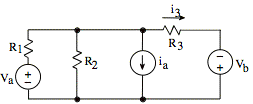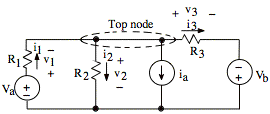![]() Unit 1
Unit 1 ![]()
1270 PRACTICE EXAM SOLUTION Prob 2
2. (30 points)
Derive an expression for i3. The expression must not contain more than the circuit parameters Va, Vb, ia, R1, R2, and R3.

ans: ![]()
sol'n: Using passive sign convention, label voltage drop and current measurement polarities.

Use Kirchhoff's laws:
sum v drops around loop = 0
sum i out of node = 0
v drops for loop on left, using Ohm's law for v1 and v2:
![]()
Middle loop would include current source, so use slightly larger loop with R2 on left and Vb on right:
![]()
Now sum currents out of top node (that consists of the two top nodes connected by a wire). Note: We are always allowed to combine nodes connected by wires.
-i1 + i2 + ia + i3 = 0 A
We now have three equations in three unknowns. We solve for i3. Use the second equation to eliminate i2:
![]()
Use the first equation to eliminate i1:
![]()
Substitute for i1 and i2 in the third equation:
![]()
Solve for i3:
![]()
![]()
Multiply both sides by R1R2 to clear fractions:
![]()
or
![]()
Now for consistency checks to verify our answer. (Optional)
1) Consider ia = 0, Vb = 0, and R3 = 0:

Since R2 is bypassed by a short, no current flows in R2. Therefore, we can remove R2 without changing i3:

Our
formula gives i3 = ![]() .
. ![]()
2) Consider ia = 0 (open circuit) and R2 = ´ (open circuit):
Removing R2 and ia leaves total voltage Va + Vb across R1 + R3 in outside loop.
Therefore, we have
![]()
For our formula, we use the following identities:
![]()
Making these substitutions in our formula gives
![]()
![]()
(3) Consider Va = 0, ia = 0:

![]()
Our
formula gives ![]() or
or
![]() .
. ![]()
(4) Consider Va = 0, Vb = 0:

By
current divider formula, we have ![]() .
.
Our
formula gives ![]() or
or
![]()
![]()
(5) Consider ia = 0, Vb = 0.

Now

Our
formula gives ![]() .
.
![]()